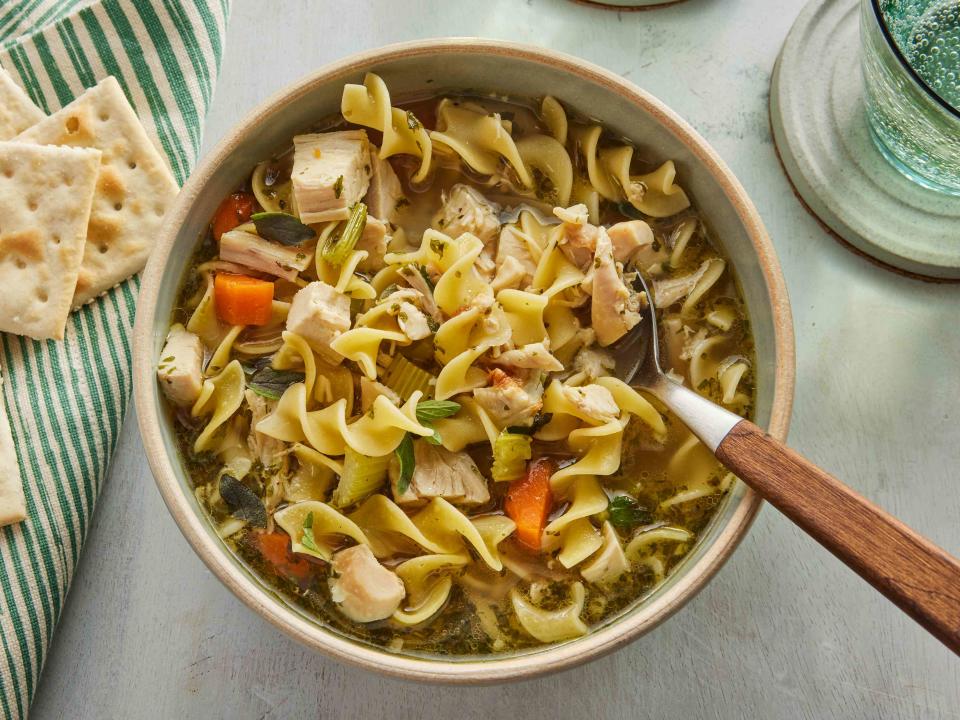The 1 Ingredient Swap That Makes Every Soup Taste Better
It's like “an onion if it were a supermodel.“

Dotdash Meredith Food Studios
There's no denying it; it's officially soup season. From savory stews to buttery bisques and creamy chowders, I want to be eating soup for as many meals as possible from here on out until spring arrives. In my quest to find the best soup recipes, I discovered there are a few secret (and not so secret) ingredients that can help make any recipe taste just *that much* better. But none is easier and more game-changing than a simple ingredient swap in any soup base that makes all the difference in the final product. Here's why you need to be adding leeks to your next soup.
Why You Should Be Cooking With Leeks
"Anything you can do, I can do better." That's what I imagine leeks sing to onions as they sit side-by-side in the produce section. And yet, they're largely overlooked. Like onions, shallots, and garlic, leeks are a member of the allium family, but their flavor is more delicate and slightly sweet than onions or green onions. But the real difference is their texture.
You only cook the tender light green and white part of the leek, which grow in concentric sheaths. When sliced thinly they cook down super quickly and caramelize in the process. They're also less fibrous than shallots or onions, so they almost melt into whatever you're cooking, disappearing but leaving a garlicky tang without any of the sharp, astringent taste that onions can have.
It's hard to describe exactly what makes leeks so good, but I recently saw a TikTok that nailed it. In it, the creator said they remembered one Michelin-starred chef saying, "If an onion were a supermodel, it would be a leek." Leeks taste luxurious and elegant, and will instantly make anything you add them to creamier, richer, and just better. Sold? Now, here's how to incorporate them into your cooking routine this winter.
How and When to Add Leeks to Dishes
The easiest way to start cooking with leeks is to add them to your mirepoix, aka, the French flavor base for any soup or savory dish. Mirepoix is traditionally one part carrot, one part celery, and two parts onions, all minced and sautéed together. You can substitute leeks for the onions entirely or use them in addition to onions.
Ideally, you want to sauté leeks in butter or olive oil (or a combination of both) to start a dish. Once they start to caramelize, either add the rest of your ingredients or set the leeks aside to add into another dish. Leeks work particularly well puréed into creamy soups like this classic potato leek soup or even a rich butternut squash soup, since they have that signature 'melty' quality.
To get your inspiration going, here are a few flavor pairings for leeks that are matches made in culinary heaven:
Leek and bacon: The smokiness of bacon and the sweetness of leeks pair gorgeously. Try them together in a quiche, dip, or bacon-y macaroni and cheese, or use both as toppings for a simple, comforting pizza.
Leek and potato: You probably know them as the most classic soup duo, whether served hot or cold. But, sautéed leeks also taste amazing mixed into mashed potatoes, as in this recipe for the traditional Irish dish, Colcannon.
Leek and cream: Creamy pasta dishes like this leek-laden Alfredo are guaranteed to convert even the most skeptical into leek lovers.
Leek and egg: Whether in a French quiche or added into a frittata, eggs and leeks are so well suited to each other. Add some cheese like goat cheese, or Swiss or Romano into the mix, and things get even more delicious.
Leek and mushroom: Rich and full of umami, mushrooms and leeks make for the most delicious base for vegetarian soups and stews, like this French mushroom stew. My go-to cream-less creamy mushroom soup recipe starts with a leek-heavy mirepoix as well.
However you choose to cook them, I hope this winter you'll give leeks a chance.
Read the original article on All Recipes.

